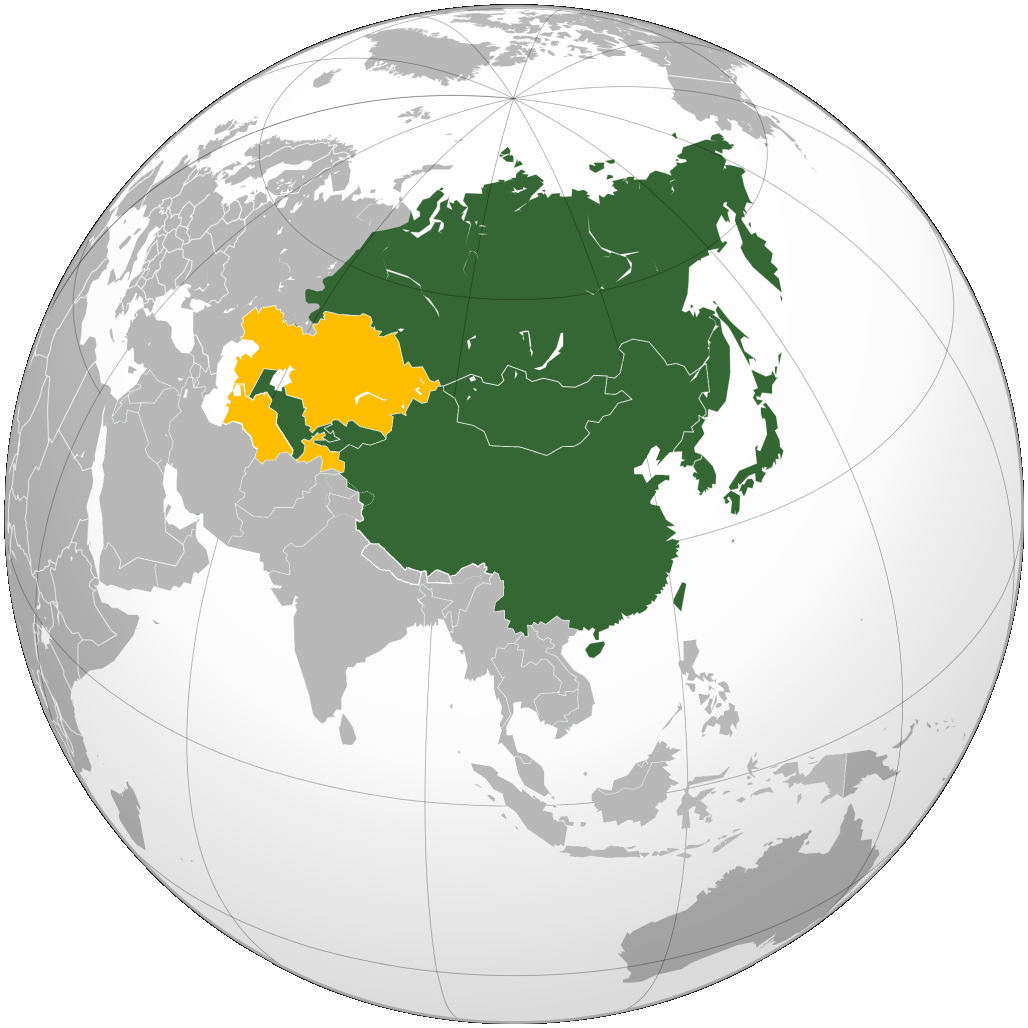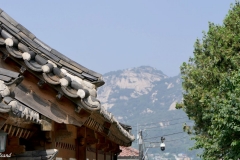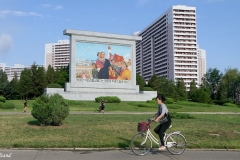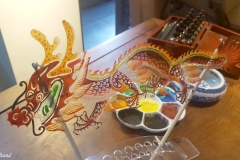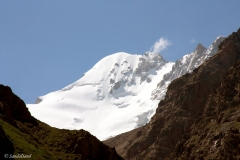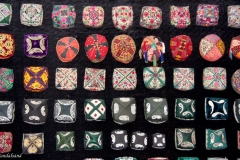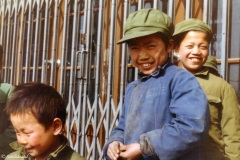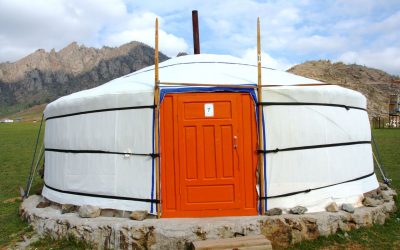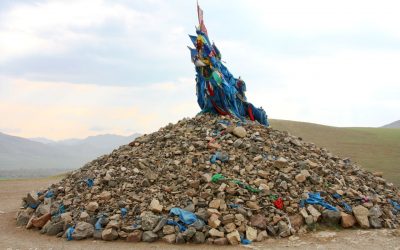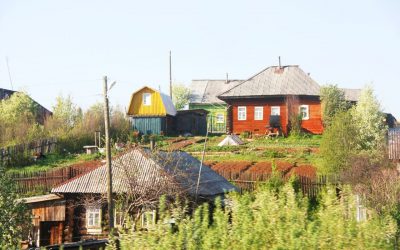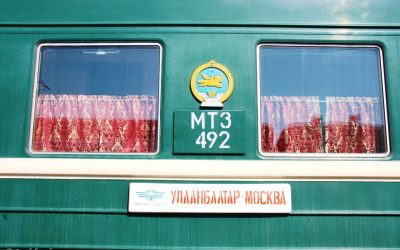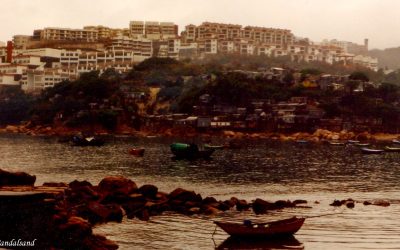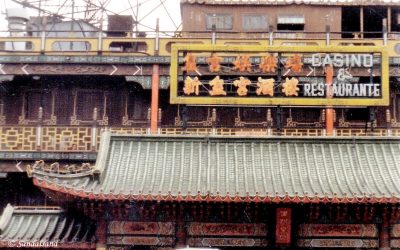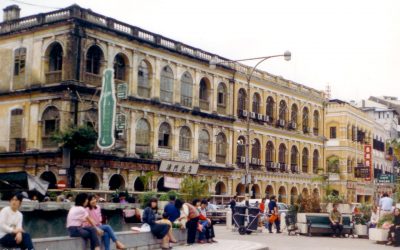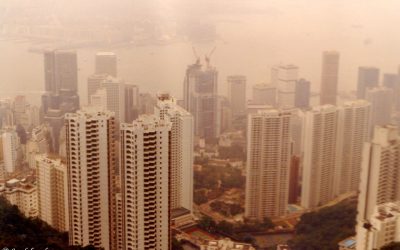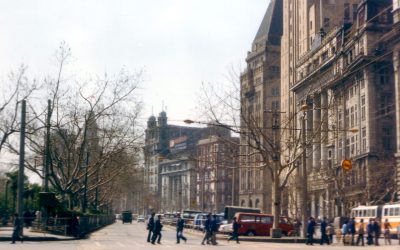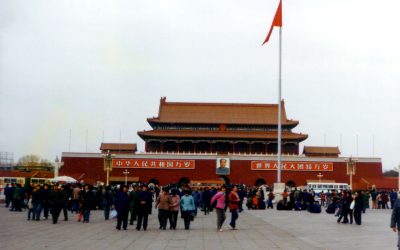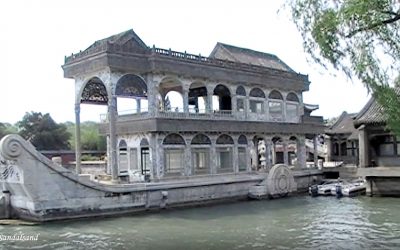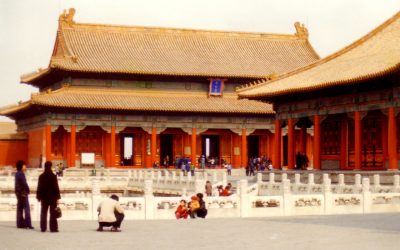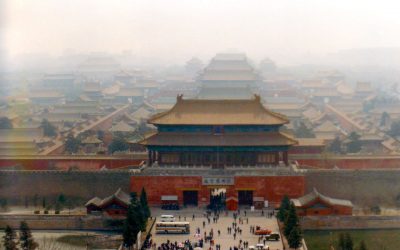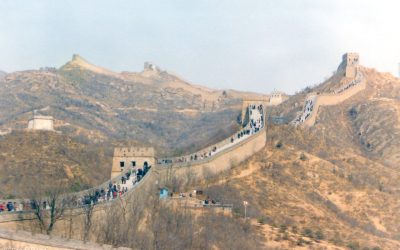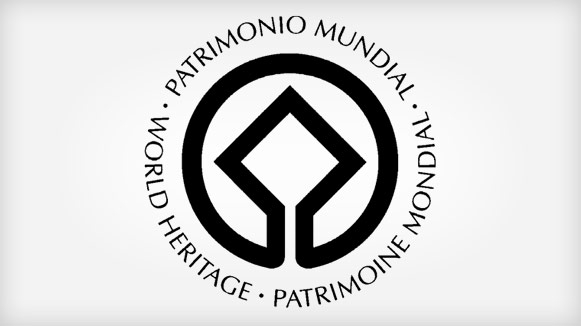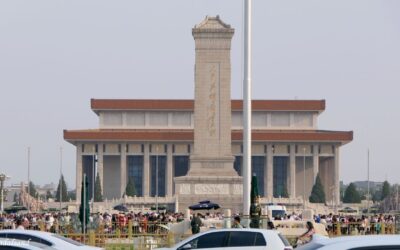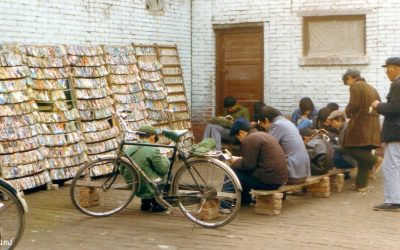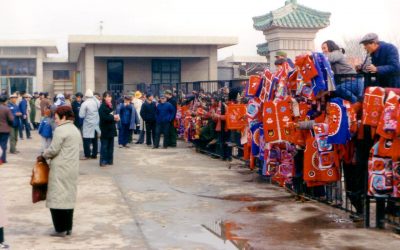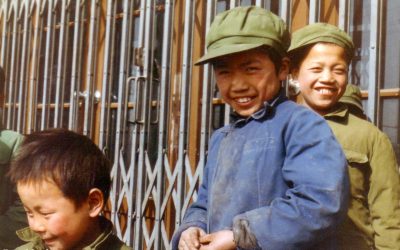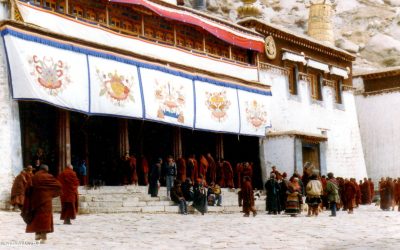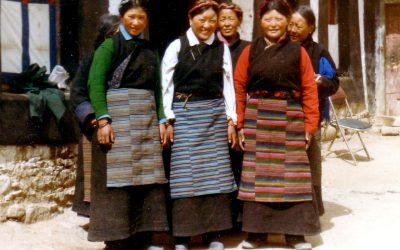Intro
Countries
Photos
Blog
Facts
Overall impressions
These women emerged from their houses at the Sera monastery in Tibet in 1985. They brushed their hair and aprons and asked us to take their pictures, so we did.
However, they were disappointed to learn that we didn’t have Polaroid cameras with instant processing and printing. They must have encountered or heard about tourists with such cameras before. No “travellers” had them, as I wrote about this scene many years ago.
In fact, this situation does not seem typical of East Asia in my opinion. People there are generally very up-to-date with technology. My impressions of this part of the world are certainly characterized by human curiosity and friendliness, combined with a traditional sense of hospitality. This holds true not only in remote places like Tibet and Mongolia but also in modern-day Japan.
An even stronger impression is the hectic way of life most East Asians lead. This is partly due to living in one of the world’s most densely populated regions, but I also believe there are cultural reasons for this.
To counteract this, it’s no surprise that the region has developed religious philosophies emphasizing deep meditation and mental balance. Today, East Asian society faces many challenging balancing acts: old and new; traditional and modern; work and leisure; manual and mental; stagnation and growth; poverty and prosperity; collectivism and individualism.
Countries
China | Japan | Kazakhstan | Kyrgyzstan | Mongolia | North Korea | Russia | South Korea | Taiwan | Tajikistan | Turkmenistan | Uzbekistan
There are three different regions under this heading. North Asia is by Wikipedia defined as Russia east of the Ural Mountains. East Asia is a larger region of six countries. Central Asia consists of five stan-countries.
Sandalsand has been to nine independent countries out of 12. The links above open lists with all articles from that particular country.
Taiwan’s status is a problem, in more than one way. I include it in this list for practical purposes.
Photo galleries
Open the box to view a multitude of picture galleries from Sandalsand’s travels in this region.
Click to show or hide
Open the box to view picture galleries from my travels in this region. I would recommend you to open a picture gallery in a new tab or window.
Distance tests a horse’s strength. Time reveals a person’s character.” (Chinese proverb)
Posts from North, Central and East Asia
VIDEO – Mongolia – Ger
This is a video from inside and outside a Mongolian Ger. It is a traditional portable, round tent covered with skins or felt and used as a dwelling....
The Gorkhi Terelj National Park in Mongolia
Well! Not bad to come to Mongolia, some of the remotest imaginable of all inland countries. We first went to the Gorkhi Terelj National Park. This...
VIDEO – Mongolia – Ankle bone shooting
This video shows a group of Mongolian men practising indoors for the national championship in ankle bone shooting. According to Wikipedia Shagai...
The Trans-Siberian Railway from Moscow to Mongolia
This is a story from the Trans-Siberian Railway from Moscow to Mongolia. Read about the days on the train, four and a half days continuously on the...
VIDEO – Russia – Lake Baikal
This video from Lake Baikal is shot from the train on the Trans-Siberian Railway. Lake Baikal is no. 754 on UNESCO's World Heritage List. According...
World Heritage #0754 – Lake Baikal
This huge lake in Siberia, Lake Baikal, is a natural phenomenon, but is also of big cultural importance to the Russians. The UNESCO World Heritage...
Introduction to the Trans-Siberian Railway
This is an introduction to the Trans-Siberian railway, "the world's longest train ride". The Trans-Siberian railway links Moscow with Vladivostok on...
Hong Kong for the last time
I was back in Hong Kong for the last time, from Macau. I spent the next couple of days relaxing and write a letter back home. This article is part...
The casinos and back streets of Macau
From Hong Kong I went on a day trip to Macau, like many people from Hong Kong do. I found their casinos and also walked into the back streets of...
World Heritage #1110 – Macao
Portugal's architectural legacy stretches from the homeland to Brazil and to Macao (Macau) on the coast of China. The UNESCO World Heritage List...
Back in Hong Kong
I was back in Hong Kong after almost 44 days in China. I spent the next days trying to recover and plan my onward journey. This article is part of a...
Shanghai and the slow boat to Hong Kong
Shanghai was an exciting experience. The European atmosphere was striking, the Chinese districts fascinating, and finally, I boarded a slow boat to...
Beijing and the Summer Palace
The story from Beijing continues with a letter home and the Summer Palace. We days in the Chinese capital were coming to an end. This article is...
World Heritage #0880 – Summer Palace
The Summer Palace is set in a large area north of Beijing with an artificial lake in the midst. Here we find numerous temples and palaces. The...
Beijing – The imperial city
Beijing: The imperial city complete with ducks, opera, acrobats and the Forbidden City. We first days ever in China's capital were full of...
World Heritage #0439 – The Forbidden City
The Forbidden city is large and impressive. Despite this, the emperors of China lived in a prison-like confinement with immense...
World Heritage #0438 – The Great Wall
The Great Wall is truly a magnificent sight. Stand on a section of the wall and watch how the fortifications roll up hills and down valleys,...
World Heritage #1004 – Ming and Qing tombs
Not far from Beijing, we may find several tombs belonging to Chinese emperors of the Ming and Qing Dynasties. The UNESCO World Heritage List...
World Heritage #1714 – Beijing Central Axis
Beijing Central Axis is a site that demonstrates both the Imperial and Communist Chinese interest in symmetry and symbolism. The UNESCO World...
Xian – Terracotta soldiers
Xian is famous for its Terracotta soldiers. I also experienced that China had a long way to go in hospitality. This article is part of a diary based...
World Heritage #0441 – Xian
The Mausoleum of the First Qin Emperor is the official name of this site. Think about terracotta soldiers in Xian and you know what it is. The...
From Lhasa to the forbidden city of Golmud
From Lhasa I managed to get a bus ticket out of Tibet, to Golmud. At that time in 1985 in was forbidden for foreigners to enter this city. Read...
The story from my days in Tibet continues
The story from my days in Tibet continues here with the bulk of the stay. I spent 11 days in all, back in 1985. This article is part of a diary...
11 days on top of the world, in Tibet
11 days on top of the world, in Tibet, a few months after it opened up for individual travellers. This post is about the two first two days and a...
When you have completed 95 percent of your journey, you are only halfway there. (Japanese proverb)
A fact sheet
North Asia

- Region: North Asia
- States and territories: Russia
- Population (2017): 33,765,005
Geography
North Asia or Northern Asia, sometimes known as Siberia, is a subregion of Asia, consisting of the Russian regions of Siberia, Ural and the Russian Far East – an area east of the Ural Mountains. The region is sometimes also referred to as Asian Russia. The total population of North Asia is about 33 million. North Asia makes up more than 75% of the territory of Russia, but only 22% of its population, at a density of 2.5 people per km2.
Demography
There are around 38 million Russians living east of the Ural Mountains, the informal divide between Europe and Asia. Native Siberians are a minority in Siberia/North Asia due to the Russification process during the last three centuries.
The Buryats numbering 445,175 is the largest ethnic minority group in Siberia. There are 443,852 Yakuts (Russian Census of 2002) living in Siberia. According to the 2002 census there are 500,000 Tatars in Siberia, but 300,000 of them are Volga Tatars who settled in Siberia during periods of colonisation. Other ethnic groups that live in the region and make a significant portion are ethnic Germans and they number about 400,000.
Source: Wikipedia.
East Asia
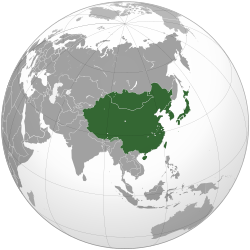
- Region: East Asia
- Area: 11,839,074 km2
- Population (2016): 1,641,908,531
- Density: 140/km2
- States: China, Japan, Mongolia, North Korea, South Korea, Taiwan
Geography
East Asia is the eastern subregion of the Asian continent, which can be defined in either geographical or ethno-cultural terms. Geographically and geopolitically, the region constitutes Greater China (Greater China consists of Chinese mainland, Hong Kong, Macau and Taiwan), Japan, Mongolia, North Korea and South Korea.
Religion
The region was the cradle of various ancient civilizations such as Ancient China, ancient Japan, ancient Korea, and the Mongol Empire. Major religions in East Asia include Buddhism (mostly Mahayana), Confucianism and Neo-Confucianism, Taoism, Ancestral worship, and Chinese folk religion in Mainland China, Hong Kong, Macau and Taiwan, Buddhism and Shintoism in Japan, and Christianity, Buddhism and Sindoism in Korea. Shamanism is also prevalent among Mongols and other indigenous populations of northern East Asia such as the Manchus.
Demography
At the present time East Asians comprise around 1.6 billion people, making up about 38% of the population in Continental Asia and 22% of the global population. The region is home to major world metropolises such as Beijing, Hong Kong, Seoul, Shanghai, Taipei, and Tokyo. Although the coastal and riparian areas of the region form one of the world’s most populated places, the population in Mongolia and Western China, both landlocked areas, is very sparsely distributed, with Mongolia having the lowest population density of a sovereign state. The overall population density of the region is 133 inhabitants per square kilometre, about three times the world average of 45/km2
Source: Wikipedia.
Central Asia
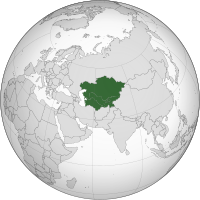
- Region: Central Asia
- Area: 4,003,451 km2
- Population: 69,787,760
- Pop. density: 17.43/km2
- Countries: Kazakhstan, Kyrgyzstan, Tajikistan, Turkmenistan, Uzbekistan
- Nominal GDP: $295.331 billion (2012)
- GDP per capita: $6,044 (2012)
Geography
Central Asia stretches from the Caspian Sea in the west to China in the east and from Afghanistan in the south to Russia in the north. The region consists of the former Soviet republics of Kazakhstan, Kyrgyzstan, Tajikistan, Turkmenistan, in addition to Uzbekistan. It is also colloquially referred to as “the stans” as the countries generally considered to be within the region all have names ending with the Persian suffix “-stan”, meaning “land of”.
By and large Central Asia has a population of about 70 million. It consists of five republics: Kazakhstan (18 million), Kyrgyzstan (6 million), Tajikistan (9 million), Turkmenistan (6 million), and Uzbekistan (31 million). Moreover, Afghanistan (35 million), which is a part of South Asia, is also sometimes included in Central Asia.
Demography and history
Otherwise Central Asia has historically been closely tied to its nomadic peoples and the Silk Road. It has acted as a crossroads for the movement of people, goods, and ideas between Europe, Western Asia, South Asia, and East Asia. The Silk Road connected Muslim lands with the people of Europe, India, and China. In time, this crossroads position has intensified the conflict between tribalism and traditionalism and modernization.
In pre-Islamic and early Islamic times, Central Asia was predominantly Iranian, populated by Eastern Iranian-speaking Bactrians, Sogdians, Chorasmians and the semi-nomadic Scythians and Parthians. After expansion by Turkic peoples, Central Asia also became the homeland for the Kazakhs, Uzbeks, Tatars, Turkmen, Kyrgyz, and Uyghurs. Due to this, Turkic languages largely replaced the Iranian languages spoken in the area.
From the mid-19th century until almost the end of the 20th century, most of Central Asia was part of the Russian Empire and later the Soviet Union, both Slavic-majority countries. Moreover, the five former Soviet “-stans” are still home to about 7 million ethnic Russians and 500,000 Ukrainians.
Source: Wikipedia. All quotes are on a Creative Commons Attribution-ShareAlike License. Date: 2018-06-22

